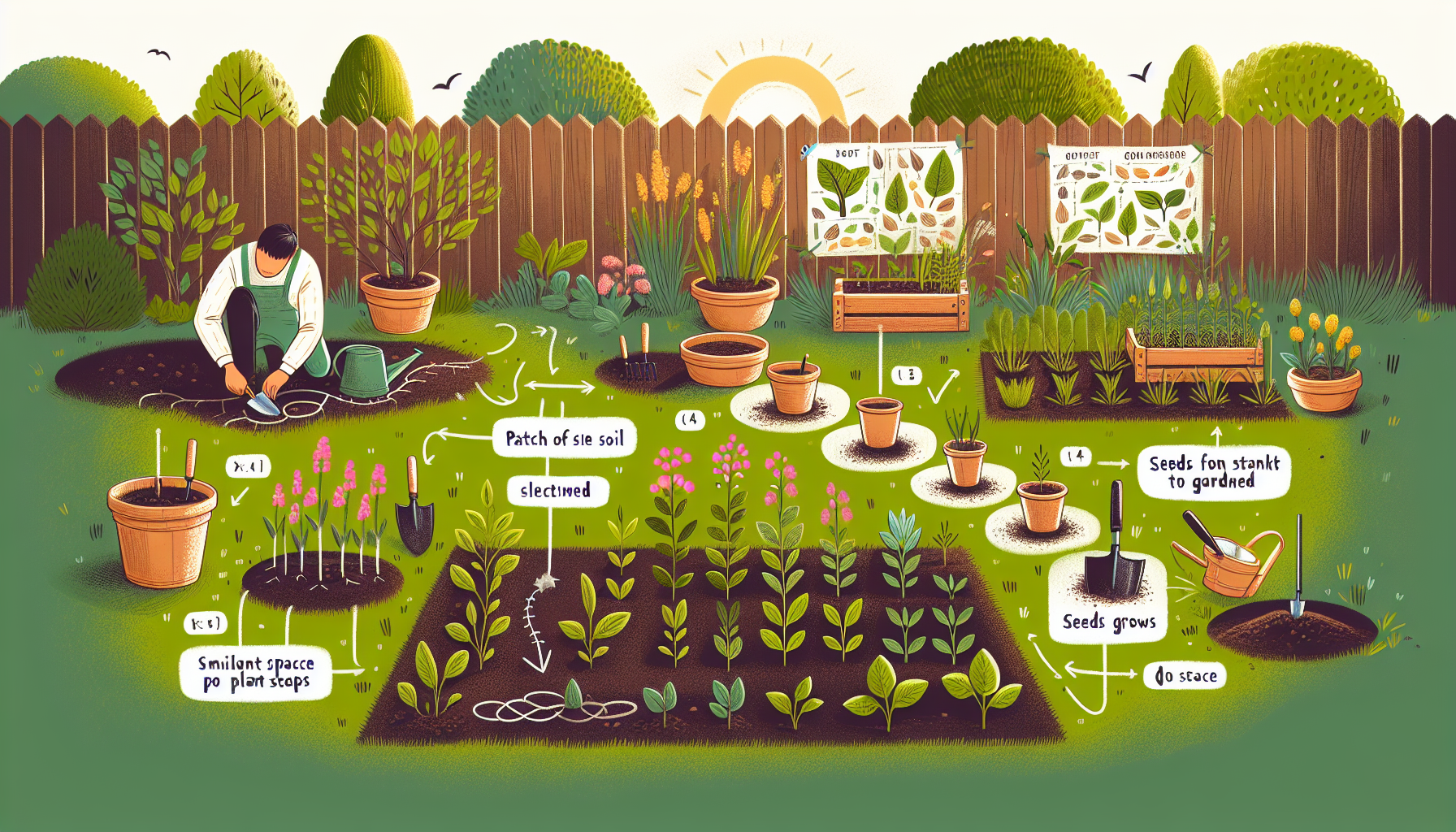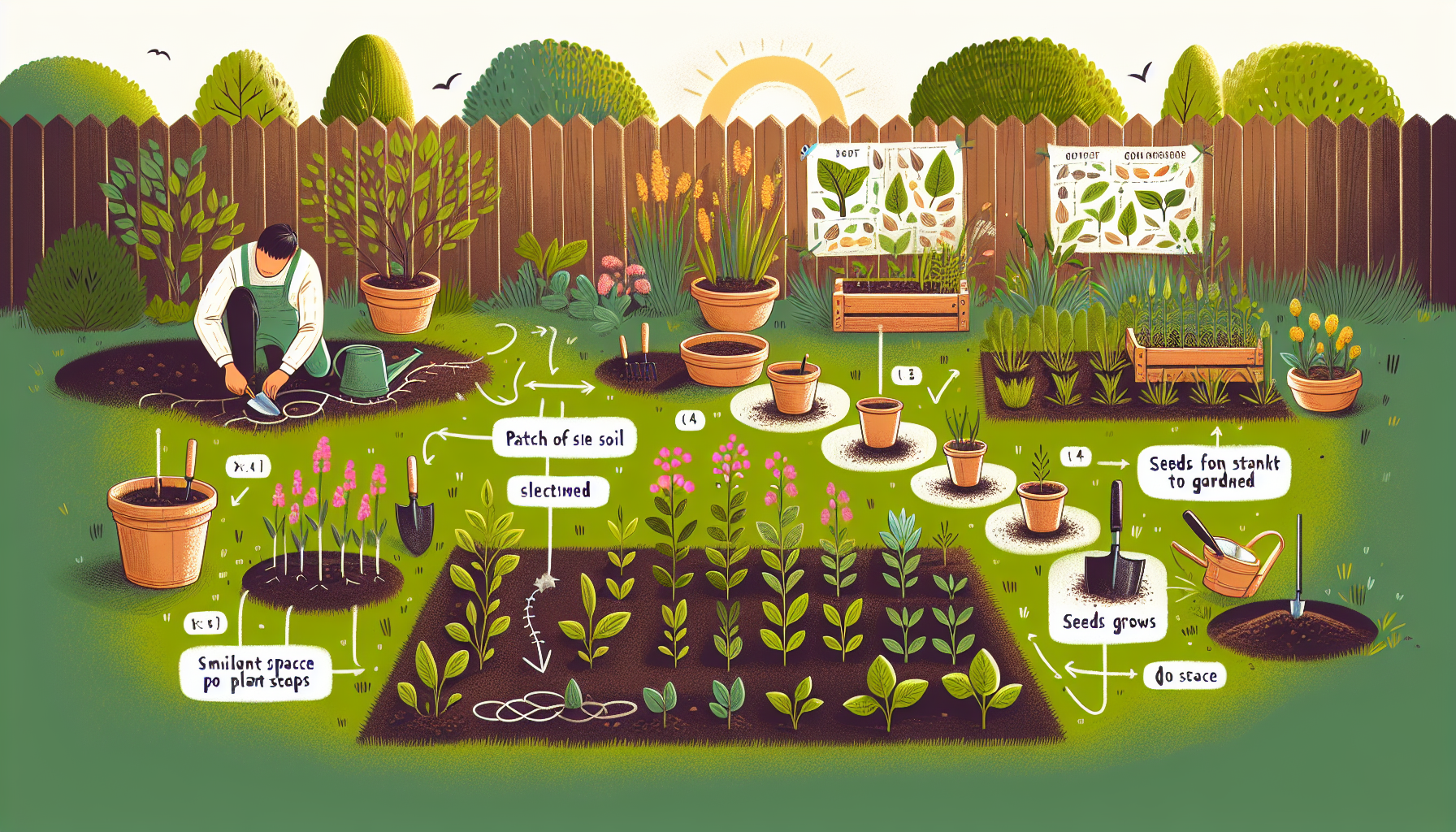So, you’ve been dreaming of transforming your backyard into a beautiful garden oasis, but you’re not quite sure where to start? Well, fear not! In this article, we’ll provide you with some simple and practical tips on how to get your garden started. Whether you’re a seasoned green thumb or a complete gardening novice, we’ve got you covered. From choosing the right location to prepping the soil and selecting the perfect plants, we’ll guide you every step of the way, so you can turn your backyard into a flourishing haven in no time. So grab your gardening gloves and let’s get started!

Choosing the Right Location
When starting a garden in your backyard, one of the first things you need to consider is the location. Assessing sunlight exposure is crucial for the success of your plants. Determine which areas receive direct sunlight for a significant part of the day. Most plants require at least six hours of sunlight to thrive, so choose a spot that meets this requirement.
Besides sunlight, soil quality is another important factor to consider. Take note of the type of soil in your backyard. Is it sandy, clayey, or loamy? Different plants have different soil preferences, so understanding your soil composition will help you determine which plants will do well in your garden. Soil with good drainage and nutrient content is ideal for most plants.
In addition to soil quality, it’s important to check for drainage issues in your chosen location. Poor drainage can lead to root rot and other problems for your plants. Analyze how water drains in the area during rainfall or irrigation. If you notice any pooling or standing water, consider improving the drainage by amending the soil or creating raised beds.
Deciding on the Type of Garden
Once you’ve chosen the right location, it’s time to decide on the type of garden you want to create in your backyard. There are several options to choose from, such as a flower garden, vegetable garden, or herb garden. Each type has its own set of requirements and benefits.
A flower garden can add beauty, color, and fragrance to your backyard. You can choose a variety of flowers that bloom at different times of the year to enjoy a continuous display of vibrant blooms. Additionally, flower gardens can attract beneficial insects and pollinators, enhancing the overall health of your garden.
If you have a passion for fresh produce, a vegetable garden might be the perfect choice for you. Growing your own vegetables allows you to enjoy the freshest, most flavorful produce right from your backyard. Not only is it rewarding, but it also provides you with a sustainable and cost-effective source of food.
An herb garden is ideal for those who love to cook and enjoy the culinary pleasures of fresh herbs. In addition to enhancing your meals with aromatic flavors, herbs also have medicinal properties and can be used for various home remedies. Whether you have a large or small space, herbs are versatile and can be easily grown in containers or gardens.
Preparing the Soil
Before planting, it’s essential to prepare the soil to provide the best growing conditions for your plants. Start by clearing the designated area of any existing vegetation, such as grass or weeds. This will help prevent competition for nutrients and sunlight.
Once the area is cleared, remove any remaining weeds or grass roots to ensure they won’t reestablish themselves in your garden. It’s important to remove them entirely, including the roots, to prevent any regrowth. This can be done using hand tools or by tilling the soil.
To create loose and fertile soil, it’s crucial to loosen the soil properly. This can be achieved by using a garden fork or tiller to break up compacted soil. Loosening the soil not only improves drainage but also allows plant roots to penetrate easily and access essential nutrients.
Testing and Amending the Soil
To ensure the optimal growth of your plants, testing and amending the soil is highly recommended. Taking soil samples from various areas within your garden will help you understand its composition and nutrient levels. You can use a soil testing kit or send the samples to a local agricultural extension or soil testing laboratory for analysis.
Based on the results of the soil analysis, you can determine whether any amendments are necessary. Adjusting the soil pH is one common amendment. Different plants thrive in different pH levels, so it’s important to know your soil’s pH and make the necessary adjustments using amendments like lime or sulfur.
Additionally, adding organic matter such as compost or well-rotted manure can improve soil fertility and structure. Amendments like these provide essential nutrients to your plants and help retain moisture in the soil, promoting healthy growth.
Creating Garden Beds
Creating garden beds will help organize your garden and provide a suitable growing environment for your plants. There are various types of garden beds to choose from, including raised beds, traditional in-ground beds, and container gardens.
Raised beds are a popular choice as they offer better control over soil quality, drainage, and pest management. They are built above ground level, which allows for better aeration, improved root development, and easier access for planting and maintenance. Raised beds can be constructed using materials such as wood, bricks, or cinder blocks.
When laying out your garden beds, consider factors such as plant spacing, access to sunlight, and the overall aesthetics of your garden. Plan the layout to maximize sunlight exposure for all your plants and provide easy access for watering, harvesting, and maintenance.
Selecting Plants
Choosing the right plants for your garden is crucial for their success. Before making any decisions, research the specific needs of different plants. Consider factors such as their sunlight requirements, water needs, and growth habits.
It’s also important to consider your local climate when selecting plants. Some plants are better suited to specific climates and may require certain conditions to thrive. Look for plants that are well-adapted to your region and can withstand the temperature fluctuations and weather conditions typically experienced in your area.
Once you’ve narrowed down your choices, choose appropriate varieties of plants. Some varieties might be more disease-resistant or better suited to your specific soil conditions. Selecting the right varieties will increase your chances of having a successful and productive garden.
Purchasing and Planting
After selecting your plants, it’s time to purchase either seeds or nursery-grown plants. Consider buying plants that are healthy and disease-free. If purchasing seeds, ensure they are fresh and of good quality.
Before planting, prepare your plants by gently removing them from their containers and loosening the roots if they are root-bound. Soak the roots in water for a few minutes to rehydrate them and help prevent transplant shock.
When planting, follow the recommended spacing guidelines for each plant, ensuring they have enough room to grow and access sunlight. Dig a hole larger than the rootball, place the plant in the hole, and gently backfill with soil. Firmly press the soil around the plant to eliminate any air pockets.
Providing Adequate Water
Watering is essential for the health and growth of your plants. Determine the watering needs of your plants based on their specific requirements. Some plants may need daily watering, while others may thrive with less frequent watering.
Setting up an irrigation system can be beneficial, especially if you have a large garden or live in an area with limited water availability. Install drip irrigation or sprinklers that deliver water directly to the plants’ root zones while minimizing water waste.
When watering, it’s important to water effectively. Water deeply and thoroughly to encourage deep root growth, rather than shallow watering, which can lead to weaker root systems. Avoid overwatering, as it can cause root rot and other problems. Monitor the moisture levels in the soil and adjust your watering schedule accordingly.
Mulching and Fertilizing
Mulching is an important step in maintaining a healthy garden. Apply a layer of organic mulch, such as wood chips or straw, around your plants to conserve moisture, suppress weed growth, and improve soil fertility. Mulch also helps regulate soil temperature, keeping it cooler in hot weather and warmer during cooler seasons.
Fertilizing your garden provides essential nutrients to your plants, promoting healthy growth and productivity. There are various types of fertilizers available, such as organic and synthetic options. Follow the recommended feeding schedule for each plant, as over-fertilizing can be detrimental to their health.
Maintenance and Care
To keep your garden thriving, regular maintenance and care are necessary. Weeding and pest control should be done consistently to prevent competition for nutrients and to reduce the risk of pests damaging your plants. Regularly inspect your plants for signs of pests or diseases and address any issues promptly.
Proper pruning and deadheading of flowers encourage healthy growth and continuous blooming. Remove any dead, damaged, or diseased plant parts to maintain the overall health and appearance of your garden.
Finally, continue to provide regular watering and feeding based on the specific needs of your plants. Monitor the health and growth of your plants, and make adjustments to your maintenance routine as needed.
Starting a garden in your backyard can be a rewarding and enjoyable experience. By choosing the right location, understanding the type of garden you want, preparing the soil, selecting appropriate plants, and providing proper care, you can create a thriving garden that brings beauty, fresh produce, and a sense of fulfillment to your outdoor space. Happy gardening!

